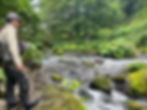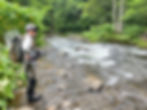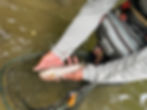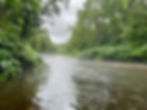Fly fishing for trout in Japan
- The Trout Bandit
- Aug 10
- 4 min read
Updated: Oct 7

Hokkaido trout fishing
While on a year-long teaching assignment in Hong Kong, it did not take long to figure out that fly-fishing is not a mainstream activity here. In fact, to call it niche would be an understatement. The same holds true for mainland China, especially for trout, but I persevered and found an opportunity to fish for iwana (white-spotted char) with a guide on the Mengtun River outside of Chengdu in Sichuan Province. It was certainly an adventure.
Finding opportunities for fly-fishing for trout (and other salmonid species) in Japan is much easier. One of the areas regularly featured for its quality trout fishing is in Hokkaido. Finding a qualified fly-fishing guide in Hokkaido also was not terribly challenging. In fact, a rod builder in the area, Kabuto Rods, introduced me to one of the more experienced guides in Hokkaido and I set my sights on a trip to Sapporo for trout fishing.
Japan is an archipelago comprising more than 6,500 islands but composed of four main islands. Hokkaido is its northernmost island, with Sapporo as its capital. According to the Japanese National Tourism Bureau, Sapporo is equally “a winter wonderland and summer haven” and “all about outdoor fun, great food and famous beer.” This city hosted the winter Olympics in 1972 and holds an annual snow festival that has an international following. There are direct flights to Sapporo from various Asian cities, including Hong Kong, but to get there from the USA will require a connection through Tokyo.

My fly-fishing guide, Iwao Shimoyama (Shimo) of Dolly Varden fishing, suggested I stay in Sapporo and have him collect me at my hotel for each day of fishing. He mentioned that there were several options outside of Sapporo to target trout, so I booked two days of fishing with him to be able to experience the different prospects for trout fishing in the area.
Based on my research, there are several salmonid species in Japan, many of which I had never heard of. In addition to rainbow trout and dolly varden, there are white spotted char (the aforementioned iwana), and native species such as masu trout, or yamame, which is the landlocked version of sea-run cherry salmon, or sakuramasu, which is like our steelhead.

Our first excursion would be to Furano to the northeast of Sapporo. Although only 90 miles away, it takes upwards of 2 ½ hours to reach by car because of the single-lane mountain roads. Furano is primarily a rural town known for tourism and agriculture and has vast, picturesque landscapes, predominately lavender, poppy and sunflower. Garden centers border the roadway with colorful displays of the summer flora of the region.

We would be fishing the Nishitatsupu river, a tributary of the Sorachi river. By 10am we were on the water, which was flowing nicely and slightly stained under overcast skies. Most of our fishing targeted long, deep runs following cascading water, as well as around structure – the bottom was thick with rocks that were very slick. I needed felt soles and a wading staff.
Shimo supplied me with a five weight flyrod with colored 3x leader and 4x tippet. We exclusively fished a size 12 prince nymph under a foam indicator as there was no reason to change up. This proved one of those days that anglers dream of with dozens of fish in the net over the course of the day. Most of these were smaller rainbows and ugui (Japanese dace). But we also put a few sizeable rainbows in the net, as well as reasonably sized iwana. At the end of the day’s fishing, Shimo told me that it was his best day of the season – I am still thanking the fishing gods!

The following day we headed to the Niseko area, which is southwest of Sapporo and a 2 hour drive, also due to single-lane mountain roads. Niseko is known as an international ski destination renowned for its snow powder. In summer it evolves into a hiking, mountain biking and fishing destination (as well as kayaking on the Shiribetsu river). Sapporo residents also flock to the many hot springs resorts that surround this alpine destination.
Here we would target two different waters – the Shiribetsu and Oroenshiribetsu rivers. Overnight rains created questionable conditions. As we drove through the mountains on the way to fishing, we saw some fast-moving waters resembling chocolate milk – not good. A dense fog was settling in, and numerous squalls created a sense of impending doom for our second day of fishing. But when we got to our destination, the water conditions were not ideal, but passable, and the rain had stopped. I was cautiously optimistic.

These riverbeds were also rocky, but not as slick as the prior day. Having said that, I still need the felt soled wading shoes and staff (the latter now becoming a default instrument on any water with structure). The water was also different, with numerous riffles and bubble lines hugging the opposite bank (the classic trout food conveyor belt), so we focused on those as well as the foamy chutes leading from cascades.
The more challenging conditions of this second day had us changing up the fly more often. We started by going smaller with the prince nymph (to size 14), then switched to a large caddis to replace the foam indicator and then went small again on both the caddis and prince nymph. I cannot complain about the production on day two as we hit low double digits, but it was nothing like day one. We also did not see a fish over ten inches.

The upside to day two was my fortune at putting a challenging prospect in the net – the masu trout, or yamame, which is referred to as the “queen of the mountain streams”. They are very wary and you apparently do not get many shots at these feisty creatures. Like my favorite SNP brookies, they thrive on dry flies in summer and do not get much bigger than 8 inches. They also radiate bold, colorful par markings from the bottom of the net.
My trip to Sapporo was one adventure that I hope to experience again.
Tight Lines!
Tanoshii go-ryoko o (pleasant travels)!
